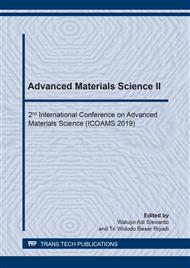[1]
K. Morsi, Review: reaction synthesis processing of Ni–Al intermetallic materials,, Materials Science and Engineering: A, vol. 299, no. 1–2, p.1–15, Feb. (2001).
DOI: 10.1016/s0921-5093(00)01407-6
Google Scholar
[2]
P. Zhu, J. C. M. Li, and C. T. Liu, Adiabatic temperature of combustion synthesis of Al–Ni systems,, Materials Science and Engineering: A, vol. 357, no. 1–2, p.248–257, Sep. (2003).
DOI: 10.1016/s0921-5093(03)00249-1
Google Scholar
[3]
G. Sauthoff, Basics of Thermodynamics and Phase Transitions in Complex Intermetallics,, Vol. 1. London: World Sceintific, 2008, p.147.
Google Scholar
[4]
Wei Li Ren, Jian Ting Guo, Gu Song Li, Jian Sheng Wu., Tensile Creep Behavior of NiAl-9Mo Eutectic Alloy,, Materials Science Forum, Vols. 475-479, pp.763-766, (2005).
DOI: 10.4028/www.scientific.net/msf.475-479.763
Google Scholar
[5]
N. S. Stolo, C. T. Liu, and S. C. Deevi, Emerging applications of intermetallics,, Intermetallics, vol. 8, p.1313–1320, (2000).
DOI: 10.1016/s0966-9795(00)00077-7
Google Scholar
[6]
P. Kitabjian, A. Garg, R. Noebe, The solid-solution alloying effects of Ti on the high temperature deformation behavior of NiAl single crystals high-temperature ordered intermetallic alloys, VII. C.C. Koch, C.T. Liu, N.S. Stoloff (eds.), Pittsburgh Penn.: Materials Research Society 460 (1997) 479–486.
DOI: 10.1557/proc-460-479
Google Scholar
[7]
L. Y. Sheng, Microstructure, Mechanical and Tribological Properties of the Rapidly Solidified NiAl/Cr(Mo,Dy) Hypoeutectic Alloy,, Materials Science Forum, Vol. 849, pp.590-596, (2016).
DOI: 10.4028/www.scientific.net/msf.849.590
Google Scholar
[8]
Li Ma, Hong Zhi Cui, Li Li Cao, Fang Lei Teng, Ning Cui, Lei Liu, The Synthesis of Porous TiC-TiB2-NiAl Composites by SHS,, Advanced Materials Research, Vols. 634-638, pp.2110-2118, (2013).
DOI: 10.4028/www.scientific.net/amr.634-638.2110
Google Scholar
[9]
Riyadi T.W.B, Tao Zhang, Denis Marchant, Xiaomeng Zhu, NiAl–TiC–Al2O3 composite formed by self-propagation high-temperature synthesis process: Combustion behaviour, microstructure, and properties,, Journal of Alloys and Compounds Volume 805, 15 October 2019, Pages 104-112.
DOI: 10.1016/j.jallcom.2019.04.349
Google Scholar
[10]
J. C. Schuster, Critical data evaluation of the aluminium-nickel-titanium system,, Intermetallics, vol. 14, p.1304–1311, (2006).
DOI: 10.1016/j.intermet.2005.11.027
Google Scholar
[11]
G. P. Cammarota, A. Casagrande, G. Poli, and P. Veronesi, Ni–Al–Ti coatings obtained by microwave assisted SHS: Effect of annealing on microstructural and mechanical properties,, Surface and Coatings Technology, vol. 203, no. 10–11, p.1429–1437, Feb. (2009).
DOI: 10.1016/j.surfcoat.2008.11.017
Google Scholar
[12]
I. Belova, N.S. Kulkarni, Y.H. Sohn, G. Murch, Simultaneous measurement of tracer and interdiffusion coefficients: an isotopic phenomenological diffusion formalism for the binary alloy,, Phil. Mag. 93 (2013) 3515–3526.
DOI: 10.1080/14786435.2013.813982
Google Scholar
[13]
I. Belova, N. Kulkarni, Y. Sohn, G. Murch, Simultaneous tracer diffusion and interdiffusion in a sandwich-type configuration to provide the composition dependence of the tracer diffusion coefficients,, Phil. Mag. 94 (2014) 3560–3573.
DOI: 10.1080/14786435.2014.965234
Google Scholar
[14]
I. Boromei, A. Casagrande, F. Tarterini, G. Poli, P. Veronesi, and R. Rosa, Ni–Al–Ti coatings obtained by microwave assisted SHS: Oxidation behaviour in the 750–900°C range,, Surface and Coatings Technology, vol. 204, no. 11, p.1793–1799, Feb. (2010).
DOI: 10.1016/j.surfcoat.2009.11.018
Google Scholar
[15]
Riyadi T.W.B., Tao Zhang, Denis Marchant, Xiaomeng Zhu, Synthesis and fabrication of NiAl coatings with Ti underlayer using induction heating, Surface and Coatings Technology,, Volume 258, 15 November 2014, Pages 154-159.
DOI: 10.1016/j.surfcoat.2014.09.037
Google Scholar
[16]
Radu L. Orban, Mariana Lucaci, Mario Rosso, Marco Actis Grande, NiAl Behavior at Plasma Spray Deposition,, Materials Science Forum, Vols. 534-536, pp.1545-1548, (2007).
DOI: 10.4028/www.scientific.net/msf.534-536.1545
Google Scholar
[17]
A. G. Merzhanov, Combustion Processes That Synthesize Materials,, Journal of Materials Processing technology, vol. 56, no. Elsevier, p.222–243, (1996).
DOI: 10.1016/0924-0136(95)01837-9
Google Scholar
[18]
J. J. Moore and H. J. Feng, Combustion synthesis of advanced materials: Part I. Reaction parameters,, Progress in Materials Science, vol. 39, no. 4–5, p.243–273, Jan. (1995).
DOI: 10.1016/0079-6425(94)00011-5
Google Scholar


